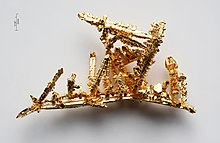Gold jewellery
 |
|||||||||||||||||||||||||||||||||
| General properties | |||||||||||||||||||||||||||||||||
|---|---|---|---|---|---|---|---|---|---|---|---|---|---|---|---|---|---|---|---|---|---|---|---|---|---|---|---|---|---|---|---|---|---|
| Pronunciation |
/ˈɡoʊld/ GOHLD |
||||||||||||||||||||||||||||||||
| Appearance | metallic yellow | ||||||||||||||||||||||||||||||||
| Standard atomic weight (Ar, std) | 196.966569(5) | ||||||||||||||||||||||||||||||||
| Gold in the periodic table | |||||||||||||||||||||||||||||||||
|
|||||||||||||||||||||||||||||||||
| Atomic number (Z) | 79 | ||||||||||||||||||||||||||||||||
| Group, period | group 11, period 6 | ||||||||||||||||||||||||||||||||
| Block | d-block | ||||||||||||||||||||||||||||||||
| Element category | transition metal | ||||||||||||||||||||||||||||||||
| Electron configuration | [Xe] 4f14 5d10 6s1 | ||||||||||||||||||||||||||||||||
|
Electrons per shell
|
2, 8, 18, 32, 18, 1 | ||||||||||||||||||||||||||||||||
| Physical properties | |||||||||||||||||||||||||||||||||
| Phase (at STP) | solid | ||||||||||||||||||||||||||||||||
| Melting point | 1337.33 K (1064.18 °C, 1947.52 °F) | ||||||||||||||||||||||||||||||||
| Boiling point | 3243 K (2970 °C, 5378 °F) | ||||||||||||||||||||||||||||||||
| Density (near r.t.) | 19.30 g/cm3 | ||||||||||||||||||||||||||||||||
| when liquid (at m.p.) | 17.31 g/cm3 | ||||||||||||||||||||||||||||||||
| Heat of fusion | 12.55 kJ/mol | ||||||||||||||||||||||||||||||||
| Heat of vaporization | 342 kJ/mol | ||||||||||||||||||||||||||||||||
| Molar heat capacity | 25.418 J/(mol·K) | ||||||||||||||||||||||||||||||||
Vapor pressure
|
|||||||||||||||||||||||||||||||||
| Atomic properties | |||||||||||||||||||||||||||||||||
| Oxidation states | 5, 3, 2, 1, −1, −2, −3 (an amphoteric oxide) | ||||||||||||||||||||||||||||||||
| Electronegativity | Pauling scale: 2.54 | ||||||||||||||||||||||||||||||||
| Ionization energies |
|
||||||||||||||||||||||||||||||||
| Atomic radius | empirical: 144 pm | ||||||||||||||||||||||||||||||||
| Covalent radius | 136±6 pm | ||||||||||||||||||||||||||||||||
| Van der Waals radius | 166 pm | ||||||||||||||||||||||||||||||||
|
|||||||||||||||||||||||||||||||||
| Miscellanea | |||||||||||||||||||||||||||||||||
| Crystal structure | face-centered cubic (fcc) | ||||||||||||||||||||||||||||||||
| Speed of sound thin rod | 2030 m/s (at r.t.) | ||||||||||||||||||||||||||||||||
| Thermal expansion | 14.2 µm/(m·K) (at 25 °C) | ||||||||||||||||||||||||||||||||
| Thermal conductivity | 318 W/(m·K) | ||||||||||||||||||||||||||||||||
| Electrical resistivity | 22.14 nΩ·m (at 20 °C) | ||||||||||||||||||||||||||||||||
| Magnetic ordering | diamagnetic | ||||||||||||||||||||||||||||||||
| Magnetic susceptibility | −28.0·10−6 cm3/mol (at 296 K) | ||||||||||||||||||||||||||||||||
| Tensile strength | 120 MPa | ||||||||||||||||||||||||||||||||
| Young's modulus | 79 GPa | ||||||||||||||||||||||||||||||||
| Shear modulus | 27 GPa | ||||||||||||||||||||||||||||||||
| Bulk modulus | 180 GPa | ||||||||||||||||||||||||||||||||
| Poisson ratio | 0.4 | ||||||||||||||||||||||||||||||||
| Mohs hardness | 2.5 | ||||||||||||||||||||||||||||||||
| Vickers hardness | 188–216 MPa | ||||||||||||||||||||||||||||||||
| Brinell hardness | 188–245 MPa | ||||||||||||||||||||||||||||||||
| CAS Number | 7440-57-5 | ||||||||||||||||||||||||||||||||
| History | |||||||||||||||||||||||||||||||||
| Naming | from Latin aurum, meaning gold | ||||||||||||||||||||||||||||||||
| Discovery | In the Middle East (before 6000 BCE) | ||||||||||||||||||||||||||||||||
| Main isotopes of gold | |||||||||||||||||||||||||||||||||
|
|||||||||||||||||||||||||||||||||
|
|
Gold is a chemical element with symbol Au (from Latin: aurum) and atomic number 79. In its purest form, it is a bright, slightly reddish yellow, dense, soft, malleable, and ductile metal. Chemically, gold is a transition metal and a group 11 element. It is one of the least reactive chemical elements and is solid under standard conditions. Gold often occurs in free elemental (native) form, as nuggets or grains, in rocks, in veins, and in alluvial deposits. It occurs in a solid solution series with the native element silver (as electrum) and also naturally alloyed with copper and palladium. Less commonly, it occurs in minerals as gold compounds, often with tellurium (gold tellurides).
Gold is thought to have been produced in supernova nucleosynthesis, from the collision of neutron stars, and to have been present in the dust from which the Solar System formed. Because the Earth was molten when it was formed, almost all of the gold present in the early Earth probably sank into the planetary core. Therefore, most of the gold that is in the Earth's crust and mantle is thought to have been delivered to Earth later, by asteroid impacts during the Late Heavy Bombardment, about 4 billion years ago.
...
Wikipedia


